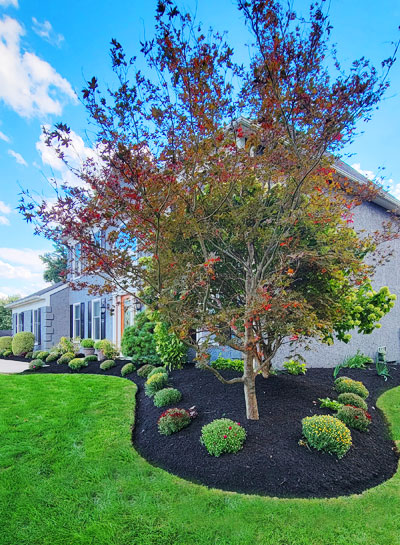Reliable Lawn Cleanup Jacksonville: Keep a Tidy and Healthy Lawn
Reliable Lawn Cleanup Jacksonville: Keep a Tidy and Healthy Lawn
Blog Article
Elevate Your Property's Visual With Sustainable Landscape Design Styles and Eco-Friendly Practices

Benefits of Sustainable Landscaping
Executing lasting landscape design practices not just saves natural sources yet likewise promotes biodiversity and enhances total ecological health and wellness. One considerable benefit is the decrease of water consumption with the usage of drought-resistant plants, rainfall yards, and reliable watering systems.
Moreover, lasting landscaping can enhance soil health and wellness by minimizing making use of chemical fertilizers and pesticides, thus producing a healthier environment for plant growth and advantageous soil microorganisms. This, consequently, improves the general resilience of the landscape to withstand ecological stress factors and environment adjustment effects - lawn cleanup Jacksonville. Furthermore, sustainable landscaping methods can bring in varied wild animals, consisting of pollinators like butterflies and bees, cultivating a more lively and well balanced ecosystem within the property
Incorporating Native Plants
To construct upon the benefits of sustainable landscape design, a calculated emphasis on incorporating native plants can additionally boost ecological durability and promote biodiversity within the landscape. Indigenous plants are varieties that normally happen in a certain location and have progressed to grow in the local environment, soil conditions, and ecosystem. By including native plants in landscaping layouts, homeowner can minimize water usage, lessen the requirement for chemical pesticides and fertilizers, and sustain the local wild animals population.
Including indigenous plants likewise aids in preserving the unique character and identity of a region's vegetation. These plants often call for much less maintenance as soon as developed, making them a sustainable and cost-effective landscaping remedy in the future. Additionally, native plants can draw in indigenous pollinators like butterflies and bees, adding to the general wellness of the ecological community.
When choosing indigenous plants for landscape design projects, it is necessary to choose types that are appropriate to the specific ecological problems of the website. Consulting with regional nurseries or arboretums can provide valuable advice on picking the best native plants for a specific area. By integrating indigenous plants into landscaping designs, homeowner can develop attractive, sustainable exterior spaces that benefit both the setting and the neighborhood.

Water Conservation Methods
Efficient watering methods play an important role in sustainable landscape design practices, making certain ideal water preservation efforts in outside rooms. Leak watering provides water straight to the roots of plants, minimizing dissipation and overflow.
Along with innovative watering techniques, xeriscaping is one more water-saving landscape design method that concentrates on utilizing drought-resistant plants, mulch, and reliable watering to produce a low-water landscape style - lawn cleanup Jacksonville. By selecting native plants that are appropriate to the local environment and soil conditions, homeowner can reduce the demand for excessive watering, ultimately preserving water and promoting a sustainable outside environment
Eco-Friendly Hardscaping Concepts
Enhancing exterior areas with environment-friendly hardscaping features can add dramatically to sustainable landscape design techniques. Decide for products like redeemed timber, recycled concrete, or all-natural stone to lessen ecological impact when thinking about hardscaping components. These materials not only include a distinct aesthetic attract your outside space however also reduce the demand for new resources removal.
Executing permeable paving options such as crushed rock or permeable concrete can help in reducing water runoff and advertise groundwater recharge. These choices enable rain to permeate right into the ground, protecting against disintegration and reducing the concern on stormwater systems.
Integrating indigenous plants right into hardscaping designs can better improve eco-friendliness by supporting neighborhood wild animals and decreasing the demand for extreme watering or chemical treatments. By incorporating vertical gardens or green walls, you can present a lot more plants into urban settings, improving air quality and biodiversity.
Integrating energy-efficient lights, such as solar-powered LEDs, right into hardscaping layouts can decrease electrical power usage and lower your home's carbon impact. Focusing on environment-friendly hardscaping concepts not only boosts the elegance of your outside space yet Web Site additionally demonstrates a dedication to environmental stewardship.
Upkeep Tips for Sustainable Landscapes

Routinely trim plants to advertise healthy and balanced development and go to this site avoid overgrowth that can lead to pest problems or diseases. Use natural fertilizers to nurture the dirt and plants without hazardous chemicals that can leach right into the atmosphere.
Final Thought
To conclude, sustainable landscape design techniques offer various benefits for homeowner, from enhancing the visual appeal of the environments to promoting ecological preservation. By integrating indigenous plants, carrying out water conservation methods, and using environment-friendly hardscaping concepts, residential or commercial property proprietors can develop stunning landscapes that are likewise ecologically liable. With correct maintenance, sustainable landscapes can add and thrive to a healthier community for both people and wildlife.
Additionally, lasting landscape design can improve soil wellness by reducing the usage of chemical fertilizers and pesticides, therefore creating a healthier environment for plant growth and beneficial dirt organisms.To build upon the advantages of sustainable landscaping, a strategic emphasis on incorporating indigenous plants can additionally enhance ecological strength and promote biodiversity within the landscape. By consisting of indigenous plants in landscaping layouts, residential or commercial property proprietors can minimize water usage, decrease the requirement for chemical pesticides and fertilizers, and support the neighborhood wild animals populace.
These plants usually call for less maintenance once developed, making them a cost-efficient and lasting landscape design remedy in the lengthy run. By read the full info here integrating indigenous plants right into landscape design designs, property owners can create gorgeous, sustainable outside spaces that profit both the neighborhood and the environment.
Report this page